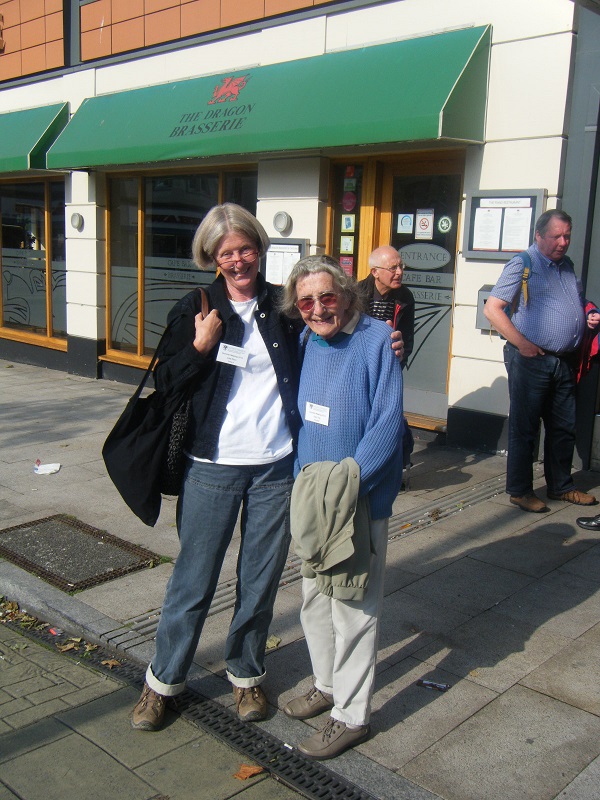
Joan when she received a blue glass weight from BIAS in 2008 
Joan with Julia Elton at a Newcomen conference in 2015
Joan was another founder member of BIAS. She and her husband Roy (who died a few years back) also edited the Journal, and Joan also organised the events for some years as well as running evening classes at the University of Bristol about Industrial history.
She had been in a nursing home for a number of months and her condition had been slowly deteriorating. She did however recently celebrate her 91st Birthday.
The funeral will be at Haycombe Cemetery. A time of 1pm on Tuesday the 28th May has been provisionally booked for the funeral.
The work she carried out to save and conserve Saltford Brass Mill and establish the Saltford Brass Mill Project is particularly important.
But her wider contribution to Industrial Archaeology must be remembered.
Joan and Roy Day attended the first series of lectures on industrial archaeology given in 1964 by Angus Buchanan and Neil Cossons (until recently the chair of English Heritage) and organized by the Extra-Mural Department of Bristol University, becoming enthusiastic supporters. The purpose of the course was to encourage students to make their own inquiries into the history of local industries. This encouraged Joan to find elderly residents who remembered their work at the Keynsham and Saltford brass mills. She has lived in Keynsham for many years. She then scoured records offices and reference libraries and tried to discover something about the techniques of brass. She was a housewife with no technical training. Research on the development of the industry took her all over England and even Europe. They then took over the course in 1970.
In 1967 they joined the local clamour for a society, Roy becoming the first Treasurer of the BIAS (Bristol Industrial Archaeological Society), Joan appeared on the Committee for 1971 – 72 as “Extra-Mural Programme Organiser”, Secretary 1973-74 and Chairman 1975-76. She has been on the Editorial Executive between 1972 to the present date. Roy was very much involved in producing the early Journals, being responsible for the layout, which basically remains the same today, but which was then at the forefront of current trends in graphics, as were his quite distinctive cover designs.
Joan wrote three articles between 1968 (the first BIAS journal) and 1976 on The Albert Mill, Keynsham, Survey; The Language of Bristol Brass; The Old Brass Mills, Saltford.
Roy also contributed five articles to the Journal between 1979 and 1995, covering subjects such as Wiltshire iron, early ferro-concrete in Bristol, lettering styles on street signs and the coming and going of early picture palaces.
Joan also wrote two books- the definitive book “Bristol Brass: The History of the Industry” in 1973 and “A Guide to the Industrial Heritage of Avon” This is a gazetteer of industrial sites written in the late 1980’s. She has also contributed articles on the brass mills to various journals.
From the 1980s, Joan and Roy were involved in the campaign to prevent the ‘development’ of the structure of Saltford Brass Mill, later joining the group working to conserve the building and open it to the public. She is still very much involved with the Mill.
She organised the Lifelong Learning Industrial Archaeological courses for 38 years with the help of Roy who unfortunately died in 2004. The courses consisting of six lectures, run every Autumn and Spring and arranged in collaboration with BIAS. They include many different topics of industrial activity in Bristol and its surrounding areas conveyed by experts in those fields.
She has also ran series of lectures at Saltford, for the Public Programmes Office, the last one being entitled “More Wealth from the Ground”. I first started going to her lectures in 2002, and have been down a stone mine, heard about mill restoration, clock restoration, beer and cider manufacture, Bristol paddle steamers, ochre mines, roman roads, canals, mining, eel trapping, the Brabazon, Brunel’s Paddington, Concorde, millstones, tar distillation, balloon history and John Cowlin amongst other things. I even met my husband Mike Taylor there!
Maggie Shapland

